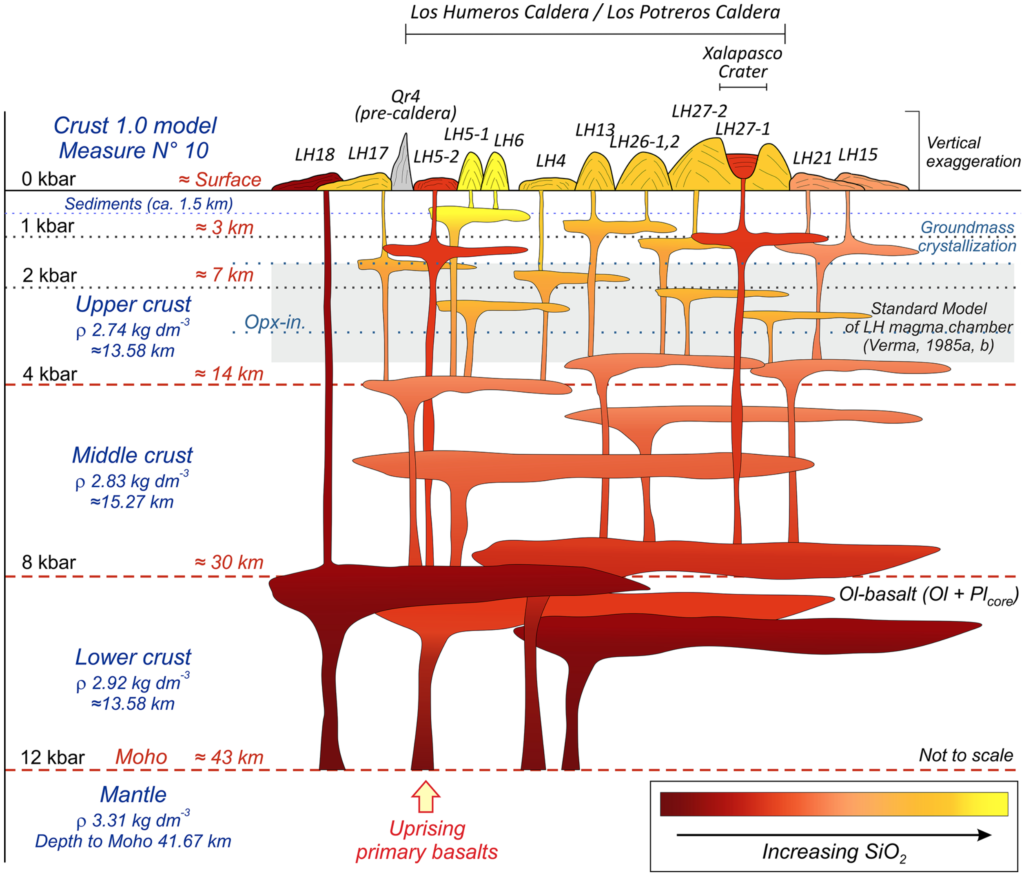Featured Image: Yosemite National Park, California, USA by Thomas H. from Pixabay
Authors: Louis F. Oppenheim, Valbone Memeti, Calvin G. Barnes, Melissa Chambers, Joachim Krause, and Rosario Esposito
Earth’s landscapes provide evidence of the geological processes which have shaped it over the past 4 billion years. The Earth’s crust, our planet’s outermost layer, preserves an extensive record of these processes. Within the crust igneous rocks which were once molten at depth and fed active volcanic eruptions, preserve evidence of the inner workings of volcanoes. These inner workings or “magmatic plumbing systems” are the focus of recent work by Oppenheim et al. (2021). In this work, Oppenheim and co-authors studied the crystal record of fossilized plumbing systems in order to provide new insights into the storage conditions and transport mechanisms of magma within Earths’ crust.
At modern day sites of active volcanic activity, lava erupts and spews hot molten material onto the Earth’s surface creating new land (new crust). This phenomenon can be currently observed, at the time of writing, in Fagradalsfjall, Iceland. But what lies beneath these active sites of volcanism? By studying the eroded remains of ancient magmatic systems, Oppenheim and co-authors deliver new perspectives on what exists beneath modern-day volcanic systems. These new perspectives challenge the idea that magma at depth is stored in discrete pockets within the Earth’s crust and accumulates incrementally over time with little to no interaction.
While diving into the depths of Earth may seem feasible in Hollywood, such explorations to the inner workings of our planet are unfortunately far from reality due to the technology required to survive the intense temperatures and pressures that would have to be withstood. Until then, we must rely on rocks from the past to tell this part of Earth’s story. The inner workings of ancient volcanoes can provide this story (Figure 1). For instance, millions of years of shifting landscapes allow these inner workings to exist at the modern-day land surface where they can be directly examined by scientists. These “magmatic plumbing systems” (see Figure 1) not only provide windows into what lies beneath currently active volcanic centers but also provide insights into how magmas interact at depth and contribute to crustal growth throughout Earth’s past.

One exceptional example of an accessible, fossilized, magmatic plumbing system can be found throughout Yosemite National Park throughout the Sierra Nevada of California (see feature image above). Here, rocks which formed 85 to 95 million years ago have been pushed to the surface from kilometers underground, preserving the roots of ancient volcanoes (see Figure 1, 2). Through the identification and tracking of individual crystals within these fossilized magmatic plumbing systems, recent work of Oppenheim et al. (2021) revealed magmas can indeed interact with each other at depth (Figure 1). In their study, Oppenheim and co-authors employed the chemical signatures of the mineral potassium feldspar (Kfs, Figure 2) as a “chemical fingerprint” of this physical processes. This crystal-scale fingerprint could then be used to trace crystals as they moved from one part of the system to the next (Figure 1, 2). These results therefore demonstrate the potential for physical exchange of material between magma batches as they cool and crystalize within Earth’s crust (Figure 1).

The interaction between, or mixing of, chemically distinct crystal populations between different magma batches at depth demonstrates that magmatic plumbing systems within Earth’s crust have the potential to have mixing bowl-like pockets of magmas. The extent to which these different magma batches (see Figure 1, 2) interact while molten implies that plumbing systems beneath volcanoes are dynamic magmatic environments where material is not only stored within Earth’s crust, but is also exchanged as has been traced by the ancient crystals in the Sierra Nevada (Figure 2). Oppenheim et al. (2021) therefore demonstrate that these magmatic systems evolve through mixing and exchange of old and new materials. Growth of these systems within Earth’s crust is therefore incremental in nature and not the result successive, single-step emplacement of material which solidifies at depth without interaction or exchange with pre-existing materials.
While today the eroded peaks of Yosemite National Park and the Sierra Nevada of California rise tall above the surrounding landscape as hardened rock, their crystal records have a different story to tell. A story of molten material that once lay kilometers beneath our feet and fed active volcanoes. This record of dynamic magmatic interaction is now frozen in time but yields important insights into what may lie beneath many of Earth’s modern-day volcanoes.


Images by Free-Photos from Pixabay
What Lies Beneath: Tracing Magma Interactions Within Earth’s Crust © 2021 by Claire McLeod is licensed under CC BY-SA 4.0

